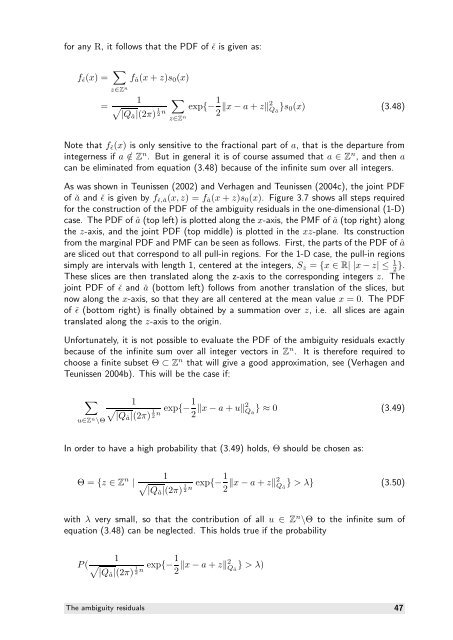The GNSS integer ambiguities: estimation and validation
The GNSS integer ambiguities: estimation and validation
The GNSS integer ambiguities: estimation and validation
You also want an ePaper? Increase the reach of your titles
YUMPU automatically turns print PDFs into web optimized ePapers that Google loves.
for any R, it follows that the PDF of ˇɛ is given as:<br />
fˇɛ(x) = <br />
fâ(x + z)s0(x)<br />
=<br />
z∈Zn 1<br />
<br />
|Qâ|(2π) 1<br />
2 n<br />
<br />
z∈Zn exp{− 1<br />
2 x − a + z2 Qâ }s0(x) (3.48)<br />
Note that fˇɛ(x) is only sensitive to the fractional part of a, that is the departure from<br />
<strong>integer</strong>ness if a /∈ Z n . But in general it is of course assumed that a ∈ Z n , <strong>and</strong> then a<br />
can be eliminated from equation (3.48) because of the infinite sum over all <strong>integer</strong>s.<br />
As was shown in Teunissen (2002) <strong>and</strong> Verhagen <strong>and</strong> Teunissen (2004c), the joint PDF<br />
of ǎ <strong>and</strong> ˇɛ is given by fˇɛ,ǎ(x, z) = fâ(x + z)s0(x). Figure 3.7 shows all steps required<br />
for the construction of the PDF of the ambiguity residuals in the one-dimensional (1-D)<br />
case. <strong>The</strong> PDF of â (top left) is plotted along the x-axis, the PMF of ǎ (top right) along<br />
the z-axis, <strong>and</strong> the joint PDF (top middle) is plotted in the xz-plane. Its construction<br />
from the marginal PDF <strong>and</strong> PMF can be seen as follows. First, the parts of the PDF of â<br />
are sliced out that correspond to all pull-in regions. For the 1-D case, the pull-in regions<br />
simply are intervals with length 1, centered at the <strong>integer</strong>s, Sz = {x ∈ R| |x − z| ≤ 1<br />
2 }.<br />
<strong>The</strong>se slices are then translated along the z-axis to the corresponding <strong>integer</strong>s z. <strong>The</strong><br />
joint PDF of ˇɛ <strong>and</strong> ǎ (bottom left) follows from another translation of the slices, but<br />
now along the x-axis, so that they are all centered at the mean value x = 0. <strong>The</strong> PDF<br />
of ˇɛ (bottom right) is finally obtained by a summation over z, i.e. all slices are again<br />
translated along the z-axis to the origin.<br />
Unfortunately, it is not possible to evaluate the PDF of the ambiguity residuals exactly<br />
because of the infinite sum over all <strong>integer</strong> vectors in Z n . It is therefore required to<br />
choose a finite subset Θ ⊂ Z n that will give a good approximation, see (Verhagen <strong>and</strong><br />
Teunissen 2004b). This will be the case if:<br />
<br />
u∈Z n \Θ<br />
1<br />
<br />
|Qâ|(2π) 1 exp{−1<br />
2 n<br />
2 x − a + u2Qâ } ≈ 0 (3.49)<br />
In order to have a high probability that (3.49) holds, Θ should be chosen as:<br />
Θ = {z ∈ Z n |<br />
1<br />
<br />
|Qâ|(2π) 1 exp{−1<br />
2 n<br />
2 x − a + z2Qâ } > λ} (3.50)<br />
with λ very small, so that the contribution of all u ∈ Z n \Θ to the infinite sum of<br />
equation (3.48) can be neglected. This holds true if the probability<br />
P (<br />
1<br />
<br />
|Qâ|(2π) 1 exp{−1<br />
2 n<br />
2 x − a + z2Qâ } > λ)<br />
<strong>The</strong> ambiguity residuals 47
















